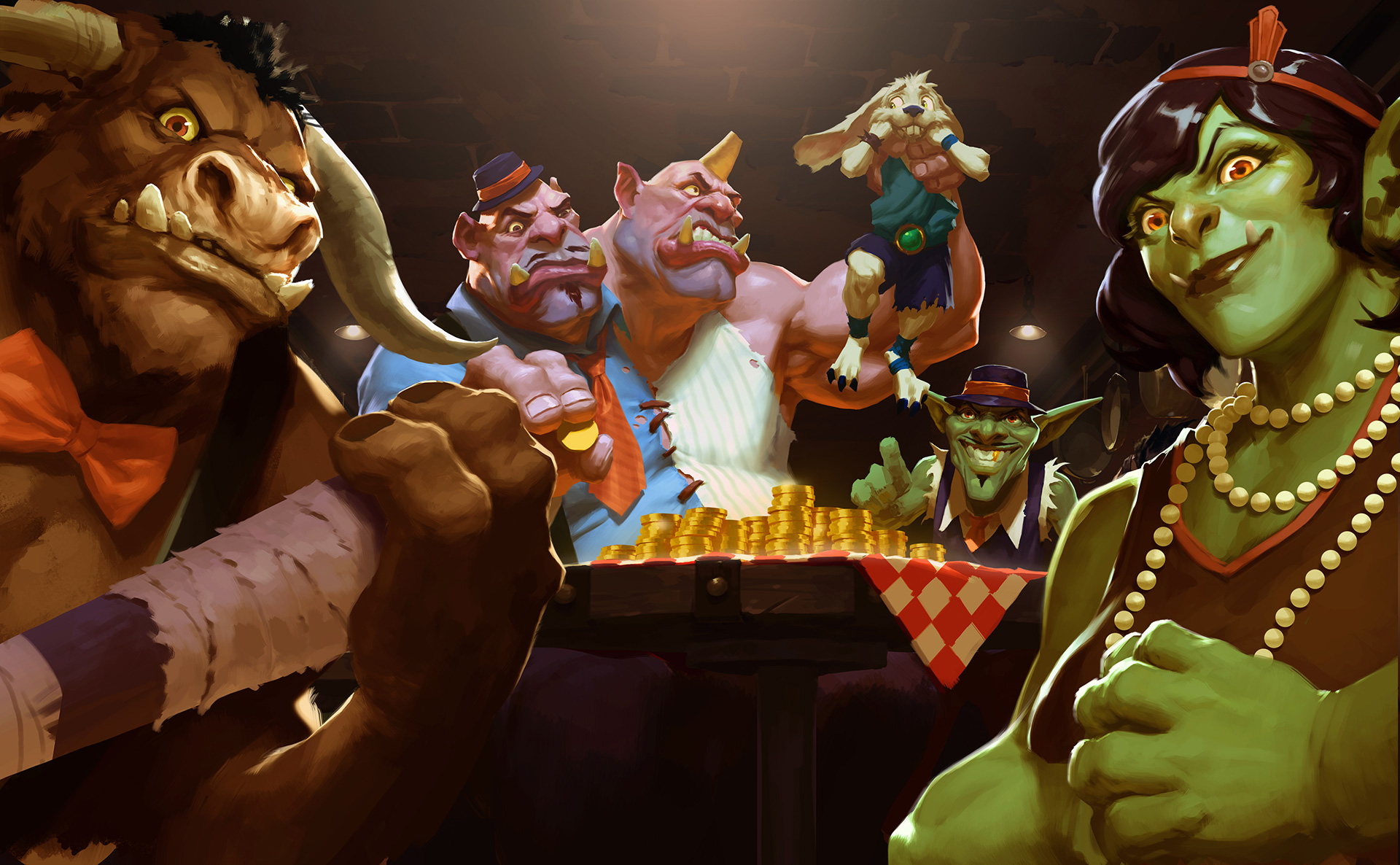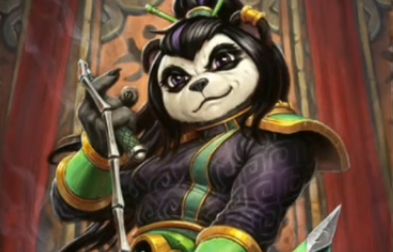
What kind of analysis do you get behind the scenes? Obviously we rely on stuff like Tempo Storm’s Meta Snapshot and the Vicious Syndicate Reaper Report, which are incomplete pictures. Do you have a big mission control with every stat at your fingertips?
Essentially, yeah. We break decks down into clusters, where we look at scenarios like: ‘Okay, these 20 cards make up a core package, and then we see these other two clusters, and the cluster of Shaman that uses Pirates is here, and the cluster of Shaman that uses Jade is here, and the cluster that uses both is here,’ and we see how all the different variations stack up, and how many total games are being played with that cluster. Sometimes there’s a cluster with very few games that just seems very high performing, but there are so few games that we don’t have enough data to be confident about the winrate.
I started playing Anyfin Paladin just because Dean said it was good.
And how are you doing?
I’m 2 and 0, so I really have only just started, but that’s a 100% win rate my friend.
[Laughs] Yeah, sometimes it’s very interesting. Sometimes there’s a deck that shows up with an insane win rate that we’ve never heard of. We have to figure it out: ‘What is this deck? Why is it playing that card? How does this deck work?’ It’s been very interesting to see some of that data that doesn’t really get elsewhere in the community because it’s like one guy with a 65% winrate who’s not telling anybody else about his deck.
In response to the Q&A, I saw Kibler recorded a long video discussing what he perceived as the current issues with Hearthstone. He called out cheap weapons specifically, saying that they’re disproportionately powerful. What do you think about that? I should warn you I have a follow-up question about Spirit Claws.
Keep up to date with the most important stories and the best deals, as picked by the PC Gamer team.
[Laughs] Well, I thought that was interesting feedback. I loved his video. I always enjoy talking to Kibler about his thoughts. That was actually a comment I hadn’t heard a lot of elsewhere in the community. Maybe it just hadn’t bubbled up to my ears yet, but it’s something to think about. Definitely there are examples where that has been an issue. There are also examples where it hasn’t. So it kind of depends on the weapon. It could be an overall problem, or it could be just a balance issue with a few of the low-cost weapons.
I said to Mike Donais last year that Fiery War Axe is the best card in the game, and he said he thought Tirion was better.
When Donais says he thinks Tirion is better, what he means is he’s probably looking at the statistics and he knows for a fact. [Laughs]
So what was the idea for a card like Spirit Claws? Shaman was in a great place, and then suddenly it gets this weapon that makes it even better at controlling the board in the early game. My guess was that what you wanted to steer Shaman into a more spell-based build, but you didn’t anticipate players incorporating it into the existing aggro and midrange decks. In the same way, I think you mentioned on stream you hadn’t foreseen that the Jade cards would just be run in the existing Shaman decks.
With Spirit Claws, our intention was to help the other classes more than we helped Shaman with Karazhan, and that didn’t quite happen.
Ben Brode, game director
That doesn’t sound too far off to me. We knew Aggro Shaman was strong, so our goal—and I think we succeeded in some ways with Wicked Witchdoctor—was to make cards that were more narrow, that would go into archetypes that were a little different. This happens sometimes, we miss up or down by 10% on a design. Perhaps we think they’re gonna be tier one, but they end up tier two or three and becoming fun cards. And sometimes we think they’re gonna be tier two and and they end up tier one, and that ends up pushing them into a place we don’t like and we have to come in and nerf things.
With Spirit Claws, our intention was to help the other classes more than we helped Shaman with Karazhan, and that didn’t quite happen. One of the things we learned from Karazhan was that this was something we didn’t want to see happen, and it happened, and that was a bummer.
It never reached the level where we felt like it was a thing that we wanted to change, but we did do a bunch of Shaman nerfs after that point that we felt like were better targets for a nerf, like Tuskarr Totemic and Rockbiter Weapon. Some of those were even more frustrating to play against. And I think that Spirit Claws, in some way, got us to the point that we had to do some of those nerfs.

Can we expect to see more shared class cards like we got with the Mean Streets gangs? I was slightly surprised that there weren’t more.
The intention there was to do a couple of things. One, sell the fantasy and the flavour of these three criminal organisations, in mechanics grounded in the fact that they work together. Normally, there are nine distinct classes, all doing different things. In this set, three classes work together to achieve a goal, and so the tri-class cards help get that message home. But the other thing is that they’re most interesting when they feel different in each of the three classes. So, with the Jade cards, Jade Druid, Jade Rogue, and Jade Shaman play very differently, and so that one Jade Spirit card actually feels almost like three totally distinct cards. I think the right thing for those was to feel kind of special and to mechanically hit those notes.
Do you worry about one of the big concepts failing to land? I’ve watched a lot of streamers bang their heads against a wall trying to make the Grimy Goons hand buff mechanic work, and it just doesn’t seem to.
Unlike Jade Golem, I don’t think we have to print a card with the hand-buffing mechanic on it in order to see the mechanic do better.
Ben Brode, game director
It does worry me, yeah. I think that some [concepts] have been very risky. C’Thun, to me, was one of the most risky things we’ve ever done. It’s a card that inherently could blow your opponent up in one turn out of your hand, which is something we’ve always been careful with and worried about, and a lot of times that’s not gone well for us. And yet, if that didn’t go well, it wasn’t one of the top mechanics of the set. It was the free legendary that we were giving out at the beginning, there are 16 cards that had the word C’Thun on. So it was a razor-thin margin where either nobody plays it or everyone is getting blown up from 30 by C’Thun every game. I think one of the biggest successes we’ve ever had from a balance perspective was how C’Thun hit that razor’s edge. And I think that Jade Golems were also that type of risk, as far as being too good or too weak.
For the Grimy Goons mechanic, I don’t think that we’ve seen the last of the Goons. I mean, individually, you can look at cards like Rat Pack and say, ‘Okay, that’s a powerful card.’ It isn’t like they’ve got cards that are just inherently weak. It’s just that somehow the whole deck doesn’t have quite the synergies it needs to hit those high levels. Also, the meta in general is a little fast right now—maybe a little faster than we anticipated it would be—and so decks that give up a little bit of early power for a little bit of late-game boost are not going to do as well in a meta like this.
So there are a couple of things that could happen. One, we could see the meta shift. If we do, maybe these kinds of decks could do better. And also, unlike Jade Golem, I don’t think we have to print a card with the hand-buffing mechanic on it in order to see the mechanic do better. For example, a card like Acolyte of Pain is interesting and pretty good, but with hand buffing it gets very interesting. Same with Wild Pyromancer. And so we could print more cards like that that, and hand buffing would become more powerful in future.

Do you worry that when there’s a mechanic that’s being pushed as part of a big theme, sometimes the optimal deck is too obvious. I feel like Jade Druid was solved in maybe one or two days.
Yeah, I think what you’re responding to there is when we design what we call a parasitic mechanic, where these cards work better when you run more of them. In general you want to put as many of those types of cards in the deck as possible and then you’ve kind of done it. Murloc is a good example of this early on in our development, right? I think that there are categories of players where this type of mechanic appeals more or less to. One of the pieces of feedback we got when we released Old Gods, and with players getting C’Thun for free, was that for some players this was the first time they’ve played a deck with any synergy, and it was pretty fun. They felt like they had a strategy and were doing cool things.

If you're interested reading more about the design process behind Hearthstone expansions, check out this fascinating post on the official forum by senior designer Max McCall. In it, he explains sets are created by two design teams ("initial" and "final"), who work on multiple expansions at once.
So, obvious build arounds, obvious parasitic mechanics, do have an audience, but depending on how we design them they can be less fun for deck builders who want a lot of room for creativity. There are pros and cons to that, but that’s partially why we don’t just put one type into each set. We try and design a variety of things.
The hand buffing is an example where that’s totally wide open. There are lots of cards that could benefit from being buffed, and there are lots of cards that do the buffing. Even just buffing a minion while it’s in the battlefield can give you some of the benefit that you’re looking for from some of these cards. So we’ll try and do a variety with each set, and sometimes the marquee mechanic will be one or the other, but there should be stuff for both types of players.
You’ve had a couple of years of doing the big set into adventure into big set, have you got any plans to change the cadence of releases in 2017?
We don’t have anything to announce right now, but I will say in general that it’s useful for us to consider our plans, consider the way we’ve been doing things, and try and figure out if we can do things better. And that’s something we’ve been doing in relation to thinking about rotations in our sets.
With over two decades covering videogames, Tim has been there from the beginning. In his case, that meant playing Elite in 'co-op' on a BBC Micro (one player uses the movement keys, the other shoots) until his parents finally caved and bought an Amstrad CPC 6128. These days, when not steering the good ship PC Gamer, Tim spends his time complaining that all Priest mains in Hearthstone are degenerates and raiding in Destiny 2. He's almost certainly doing one of these right now.


